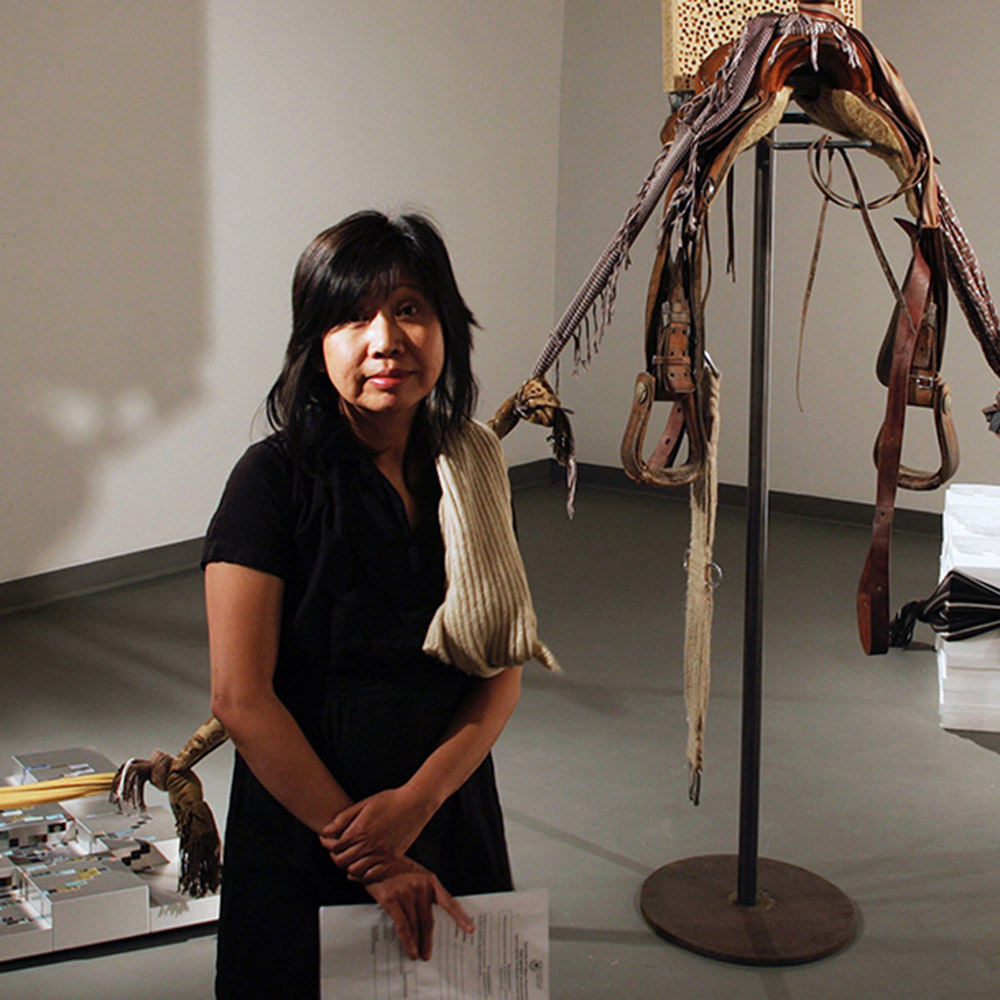MISSING CHAPTERS
Kim Huynh
Kim Huynh is a University of Calgary professor in the Department of Art Faculty of Arts. She is the first coloured faculty member and one of the first female tenure -tracks teachers in 1999 in the department. She has taught at various institutions before joining University of Calgary: The University of Alberta, University of Victoria, Guelph University, and Concordia University. Kim’s professional work has led her to sit on various committees and assist in community focused initiatives. In the past, acting as a Board Director for The New Gallery, the Calgary Vietnamese Canadian Youth, and president of Alberta Printmaker Society and founder of Artist Proof Gallery. Her artwork has been exhibited in Canada, USA, and Asia.
Her parents were originally from a small town in Guandong, China. However, she realized that three generations (herself, father, and grandfather) of her family had a “…transpacific displacement.” She left Vietnam due to the political exile in 1979, and her father could not return to China due to the China revolution’s 1949. Her grandparents owned a few businesses in Asia, and the responsibility fell to her father. He was tasked with following up on one business, and this led him to Vietnam, but instability and armed conflict broke out in China, and he was forced to settle in Vietnam, where Kim was born.
Kim says, “After the revolution in Viet Nam 1975, my brother was very keen on immigrating to Canada and USA and finding stability. He thought it would be better to be in New York at the time”. As luck would have it, the family had a distant brother-in-law in Vancouver. So there they went. “I arrived to Vancouver in 1980, and I was eighteen. I had just finished junior high, and I didn’t speak any English.” For Kim, continued education in Canada meant relearning how to function in a new system of thoughts, not just verbal or written communication, but an entire culture that was so foreign. This relearning and struggle allowed her to express herself in a second foreign language of art five years later. “There was a benefit being the youngest of five. All the expectations placed on my older siblings. I remember my father often complaining that my two older brothers did not want to go to any university or college. I decided then that it would be my goal.” She recalls that throughout her elementary and junior high years, “I was encouraged by my calligraphy teacher to practice my brush stroke and was given art materials to be used at home since there was no art course in the program.”
Kim says that, “Being an Asian student at Emily Carr University in 1984 was very active compared to the University of Victoria where I was only one of two Asian students, and there was one Black student in the program in 1988. It was very isolating and challenging to see Asian art and to discuss multicultural concerns in art”.
Undaunted, Kim became one of those idols that she sought in her university years. Kim has been teaching at the University of Calgary for seventeen years, and she consciously nurtures young students outside classroom. “I was very involved in a grassroots community and art organizations in Calgary, and I enjoyed working with university students to see creative minds grow.” Kim’s long-term research interests are in language and how globalization impacts multiculturalism in Canada. The turning point in her creative research is when YouTube appears in social media, contemporary Chinese art started flooding North America through technological ease of access. Between Kim’s BFA 1988 and 2017, she states, “Social media has allowed us to see beyond the local community which is critical to Asian Canadian artists like me. I got to teach myself many new facets of Chinese contemporary art and art methodology through the media and international critical studies, but never through art books in university.”
Kim states that “Canadian experiences of culture [ in term of art] is grounded in the lands, climates and USA’s influences. The landmass is incredibly vast, and that is both a blessing and a curse to such a small population. If you happen to live in a small town in the middle of the nation, you are isolated. In the late 80s, the Vancouver Chinese Community attempted to host the first Asian art conference in Vancouver to create an archive of Asian artists living and working in Canada. It was challenging as records of small Asian artists were spreading across the vast nation.”
Kim is currently presenting her newest exhibition “If I Had a Hammer – Part Two,” August 14, -September 08, 2017, 621 Gallery, Department of Art, University of Calgary. This part two of a series of art installations intersects with the Truth and Reconciliation, “Call for Action.” She utilizes the University of Calgary’s Gaelic motto, “Mo shùile togam suas,” which means “I will lift up my eyes,” as an opening dialogue with the campus community on indigenous issues. Minority ethnicities in Canada share a much similar cultural bias with the indigenous people. The “Call for Actions” through Canadian legacy and reconciliations elevates Canadian consciousness and will support new grounds for Indigenous youths and Canadian multiculturalism in general. “Our university is still very homogenous, and it begs the question if the interests of the minority are still adequately represented. Here, the university teaching curricula deals with not only future of youth but with history and legacy. How do you make room for issues of the marginalized knowledge of others?”
Although Kim has space and directional dyslexia and has a hard time to navigate from the Art building to Social Sciences building, Calgary is her home now, and she strives to give back to the community as much as it has given her.

